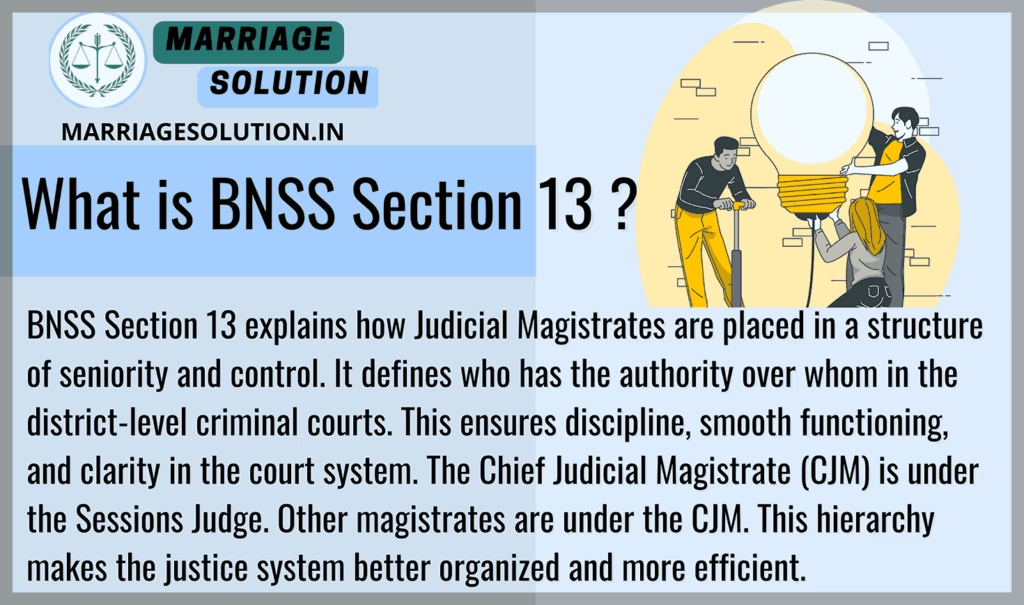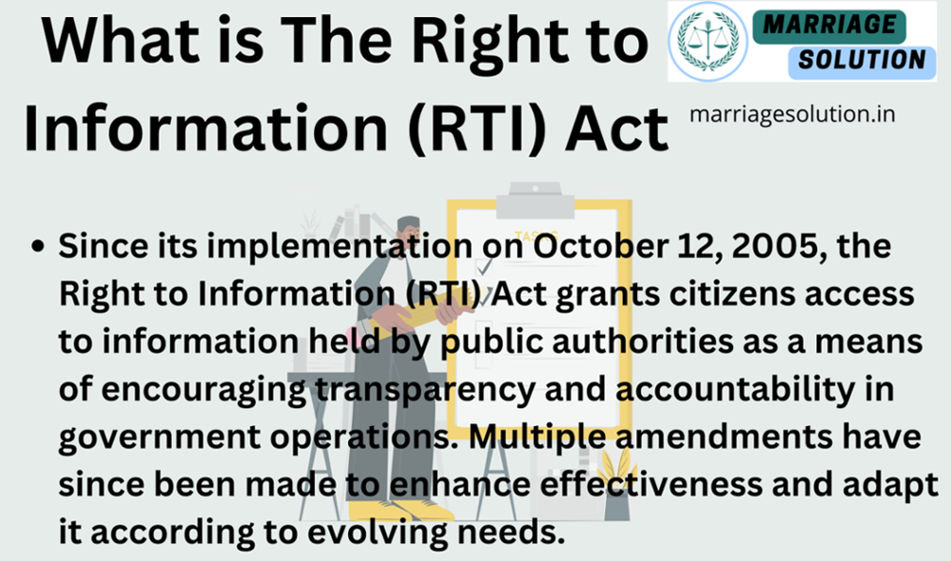Introduction of Section 13 of BNSS
Section 13 of BNSS explains how Judicial Magistrates work under a clear chain of authority. It shows that the Chief Judicial Magistrate is under the Sessions Judge, and other magistrates work under the Chief Judicial Magistrate. This structure helps courts run in an organized and disciplined way. It also ensures fair distribution of judicial work at the district level.
- Introduction of Section 13 of BNSS
- What is BNSS Section 13 ?
- BNSS Section of 13 in Simple Points
- Section 13 of BNSS Overview
- 10 Key Points of BNSS Section 13
- 1. Sessions Judge at the Top
- 2. Chief Judicial Magistrate is Second in Command
- 3. Subordination of Other Magistrates
- 4. Rule-Making Power of CJM
- 5. Fair Case Distribution
- 6. Disciplinary Control
- 7. Ensures Consistency Across Courts
- 8. Smooth Communication Chain
- 9. Quick Redressal of Court Issues
- 10. Backbone of District Judiciary System
- Examples of BNSS Section 13
- Section 13 of BNSS Short Information
- BNSS Section 13 FAQs
- If you need support with court proceedings or any other legal matters, don’t hesitate to reach out for assistance.
What is BNSS Section 13 ?
BNSS Section 13 explains how Judicial Magistrates are placed in a structure of seniority and control. It defines who has the authority over whom in the district-level criminal courts. This ensures discipline, smooth functioning, and clarity in the court system. The Chief Judicial Magistrate (CJM) is under the Sessions Judge. Other magistrates are under the CJM. This hierarchy makes the justice system better organized and more efficient.

BNSS Section of 13 in Simple Points
1. Hierarchy of Control in Courts
BNSS Section 13 clearly sets a command structure in the judicial system. At the top is the Sessions Judge, who supervises the Chief Judicial Magistrate (CJM). The CJM then manages the First Class and Second Class Magistrates under him. This chain of authority helps keep court operations organized and fair. It ensures that no one works without oversight. The structure also reduces confusion in court processes. Every Magistrate knows who they report to, which helps speed up case handling.
2. CJM’s Authority Over Magistrates
The CJM not only supervises, but also has the power to make rules or issue orders for work distribution among Judicial Magistrates. This means the CJM decides who will handle which type of cases. This helps balance workloads and avoid delays. It also ensures that serious matters go to experienced Magistrates. The CJM acts like a coordinator and manager. They help maintain discipline and check that all Magistrates follow correct procedures.
3. Sessions Judge’s Control Over CJM
The Sessions Judge holds general control over the CJM. Even though the CJM has powers, they still report to the Sessions Judge. This top-down system of control maintains the integrity of the justice process. The Sessions Judge may issue instructions or review the performance of CJMs. This keeps the lower courts accountable. It also ensures that judicial powers are not misused or poorly managed. Overall, it adds a layer of supervision to the system.
4. Non-Offence and Administrative Nature
BNSS Section 13 is not about criminal punishment—it’s an administrative provision. It doesn’t deal with crimes or penalties, but instead defines how the system should work. This is important for maintaining order in courts. Every Magistrate must follow the set rules of subordination. The clarity in roles prevents overlapping of powers. The system becomes easier to manage when everyone knows their position in the judicial chain.
5. Benefit of Structured Supervision
A structured supervisory system ensures smoother court functioning. Work is distributed properly, delays are reduced, and cases are handled efficiently. When every Magistrate knows who to report to, unnecessary confusion is avoided. This helps in faster justice delivery. It also builds public trust in the courts. BNSS Section 13 may seem technical, but it plays a big role in strengthening the base of the judicial system in India.
Section 13 of BNSS Overview
BNSS Section 13 talks about the hierarchy and control among Judicial Magistrates in the criminal justice system. It explains that Sessions Judges supervise the Chief Judicial Magistrates (CJM), and in turn, the CJM supervises all other Judicial Magistrates. This system of authority ensures discipline, smooth functioning of courts, and proper distribution of cases. It’s an administrative rule, not a criminal offence section.
10 Key Points of BNSS Section 13
1. Sessions Judge at the Top
The Sessions Judge is the highest judicial authority in the district for criminal courts. All the Chief Judicial Magistrates are under their control. This top-level supervision ensures accountability and coordination. The Sessions Judge can guide, review, or even question decisions made by CJMs. This prevents misuse of powers at lower levels. It also brings uniformity in how cases are handled. This structure supports justice at every step.
2. Chief Judicial Magistrate is Second in Command
The Chief Judicial Magistrate (CJM) is the head of all other magistrates in the district. The CJM takes instructions from the Sessions Judge and passes them to the subordinate magistrates. The CJM supervises court work, manages case distribution, and ensures that rules are followed. This central role keeps the district courts organized. CJM also acts as a mentor and guide for other magistrates.
3. Subordination of Other Magistrates
All First Class and Second Class Magistrates are under the general control of the CJM. They follow instructions related to case handling, court behavior, and scheduling. This helps in smooth and fair working of all courts in a district. If any issue arises, the CJM is the authority to resolve it. This makes the system stronger and more structured.
4. Rule-Making Power of CJM
BNSS Section 13 gives power to the CJM to make local rules for better working. These rules can be about how cases should be divided or how court timings should be managed. The CJM can also give special orders depending on the situation. These rules must follow BNSS and be consistent with legal procedures. This helps in flexible and effective administration of courts.
5. Fair Case Distribution
The CJM can divide work among the Magistrates to balance the load. For example, one Magistrate may handle domestic violence cases while another may handle theft cases. This prevents overburdening one court. It also helps in faster trials and better focus. A balanced case load improves judgment quality and saves time.
6. Disciplinary Control
If a Judicial Magistrate is not following procedures or delaying cases, the CJM can take action. This may include issuing warnings, changing work assignments, or reporting to higher authority. Such power keeps all courts functioning responsibly. It also improves public trust in the court system.
7. Ensures Consistency Across Courts
Having one supervising authority (CJM) ensures that all magistrates work in a similar way. This avoids confusion in court orders and judgments. It brings consistency in how laws are applied. People can expect equal justice, no matter which Magistrate hears their case. Uniformity builds fairness in the judicial process.
8. Smooth Communication Chain
With a clear hierarchy – Sessions Judge → CJM → Magistrates – communication becomes smooth. Orders and instructions flow easily. If any policy changes or legal updates are required, they are passed down properly. This avoids confusion and delays in implementation of rules or judgments.
9. Quick Redressal of Court Issues
If any dispute arises between magistrates or if there’s a problem in case handling, the CJM can immediately look into it. There’s no need to wait for higher court intervention. This saves time and solves small problems quickly. It helps courts run more efficiently and without conflict.
10. Backbone of District Judiciary System
This structure of subordination is the backbone of India’s criminal courts at the district level. Every officer knows their role and responsibility. It avoids overlapping of duties and improves the functioning of each court. BNSS Section 13 builds a strong, clear, and disciplined foundation for criminal justice.
Examples of BNSS Section 13
Example 1:
A Sessions Judge finds that a district court is facing case delays. He asks the Chief Judicial Magistrate to reassign some cases from an overburdened magistrate to another. The CJM follows this instruction and redistributes the workload.
👉 This example shows how the Sessions Judge controls the CJM, and the CJM manages work among subordinate Magistrates.
Example 2:
A First-Class Magistrate tries to change courtroom schedules without approval. The CJM issues a special order reminding all Magistrates that they must follow standard procedures.
👉 This example shows that the CJM can issue orders and maintain discipline among lower Magistrates under Section 13.
Section 13 of BNSS Short Information
| BNSS 13 | Details |
|---|---|
| Section | BNSS Section 13 |
| Title | Subordination of Judicial Magistrates |
| Definition | Explains the order of control between Sessions Judges, CJMs, and Magistrates |
| Offence | Not an offence; it’s an administrative provision |
| Punishment | No punishment involved |
| Bailable/Non-Bailable | Not applicable |
| Applicable To | All Judicial Magistrates under BNSS Sections 9 and 11 |
BNSS Section 13 FAQs
BNSS 13
If you need support with court proceedings or any other legal matters, don’t hesitate to reach out for assistance.
Court or any other marriage-related issues, our https://marriagesolution.in/lawyer-help-1/ website may prove helpful. By completing our enquiry form and submitting it online, we can provide customized guidance to navigate through the process.
Right to Information RTI act :Your Comprehensive Guide (Part 1)
The Right to Information (RTI) Act : Explore the essence of the Right to Information (RTI) Act through this symbolic image. The image features legal documents, emphasizing the importance of transparency and accountability in governance. The scales of justice represent…
What is Article 371 of Indian Constitution ?
Article 371 of the Indian Constitution grants special provisions to specific states and regions within India, addressing their unique historical, social, and cultural circumstances. These provisions aim to accommodate diverse needs and protect cultural identities within the constitutional framework.
Indian Labour law : Your Comprehensive Guide (Part 1)
The purpose of labour laws is to safeguard employees and guarantee equitable treatment at the workplace, encompassing aspects such as remuneration, security, and perks. These regulations establish a secure ambiance by imposing minimum wage requirements, ensuring factory safety measures are…
GST :Your Comprehensive Guide (Part 1 – Understanding the Basics)
The Goods and Services Tax (GST) is like a big change in how we pay taxes in India. It started on July 1, 2017, and it’s here to simplify things. Before GST, we had many different taxes, and it could…





